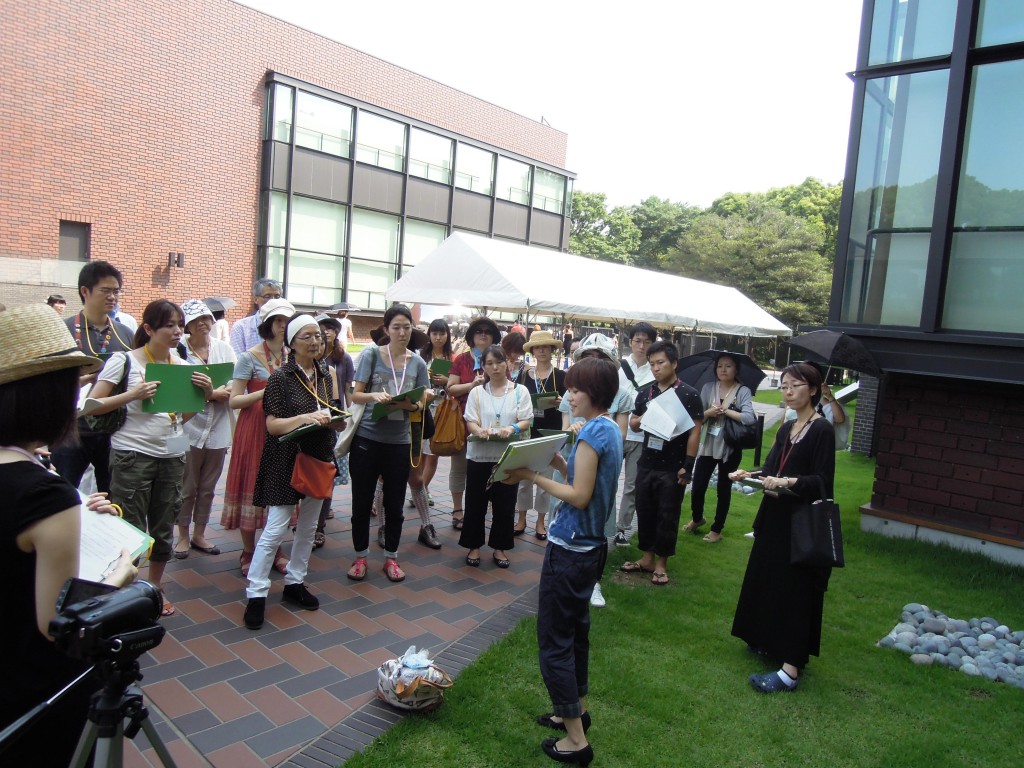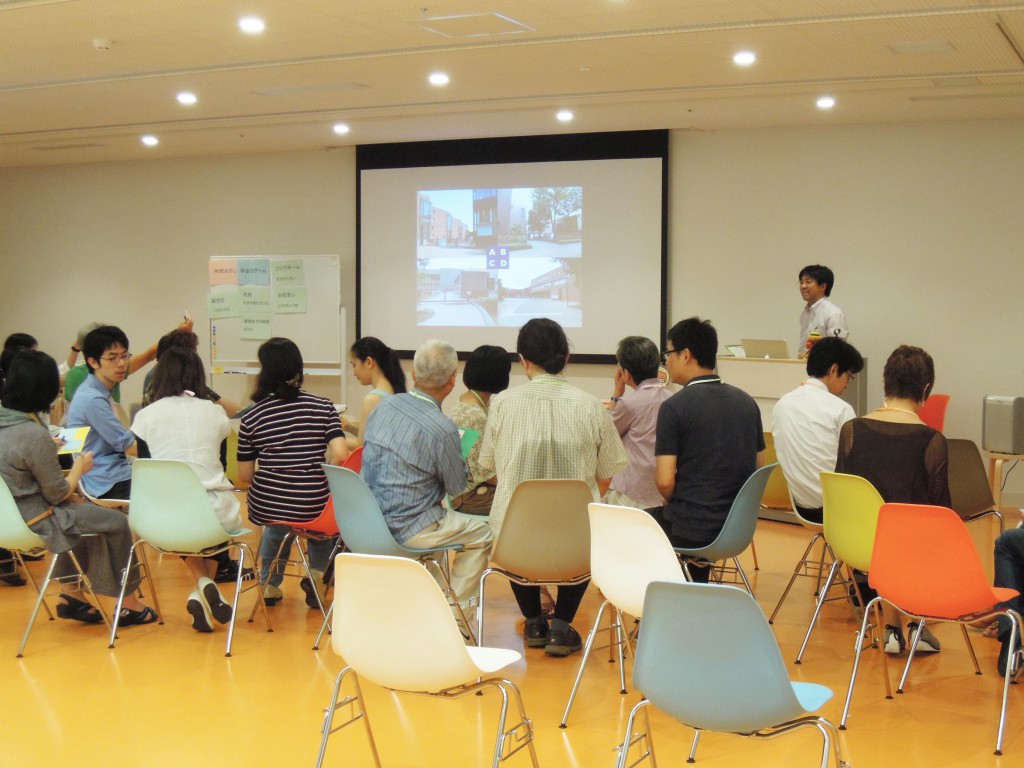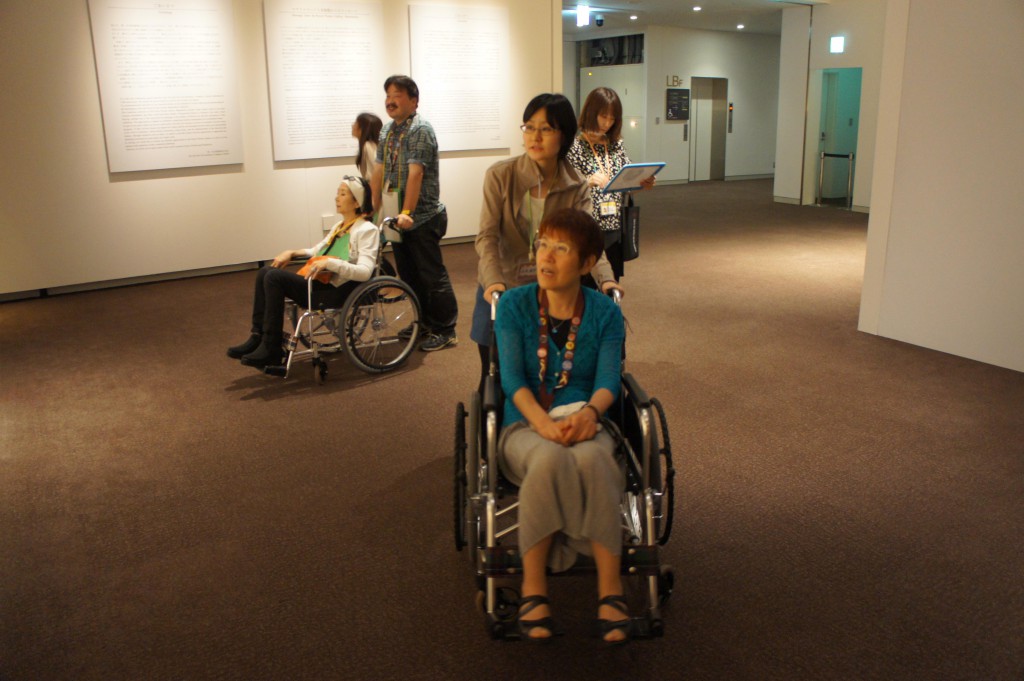
2012.07.30
3回目のアクセスプログラム(障がいのある方の為の特別鑑賞会)の実践講座も2回目同様に、白梅学園大学准教授の杉山貴洋先生を講師にお招きして、「障がい理解と特別鑑賞会会場確認」をテーマに行われました。
杉山先生から本日の流れが説明されたあとに、早速折り紙が配られ、1分間で、好きな形に紙を折るように指示が出されました。器用なとびラー候補生(以下:とびコー)はささっと鶴!まで折り上げます。そのあと、3枚重ねの軍手が配られました。分厚い軍手をはめて、先ほどの1分間の折り紙と同じ形に折ってゆきます。しかし、全く思う様に折ることができません。これは、障がい理解のための体験などでよく使われる手法とのことでしたが、出来るはずと思っていた紙を折るイメージと、動かない手のギャップは想像以上の様子。更に杉山先生からは、身体の不自由に対する理解やサポートを考えるだけでなく、障がいのある方の心的なストレスにも同時に配慮をすべきとのお話を頂きました。例えば、入口から展示室までの誘導や、エレベータの案内表示など、視覚提示できるものを使いながら、予め来館者に行動の見通しを示すことも、安心して鑑賞できる会場とするには、かかすことのできない配慮とのことでした。
次は北口玄関前です。北口はリニューアルにともなって出来た新しい入口なので、ご存知が無い方も多いかと思います。場所は搬入口の並びとなっており、タクシーでご来館頂く場合などは、一番利便性のよい玄関です。特別鑑賞会では、車椅子での来館者が多くなることが予想されます。どの様に対応したらよいか、講師が手取り足取り教えてくれるわけではありません。とびコーさんが自らか考え、最善の対応を一つひとつ確認して行きます。自らが考え、共有して、行動するのがとびらプロジェクト流です。
そして展示室の中。前回の実践講座でも車椅子に乗って鑑賞体験を行うなどの研修を実施しましたが、展示室には何度も足を運んで、会場の雰囲気や人の流れのイメージを体で覚えることはとても大事なことです。この日は休室日で他の来館者はいません。グループごとにとびコーさん同士で相談をしながら、展示室の確認をしていました。
2012.07.28
建築ツアー実践講座の3回目が行われました。とびラー候補生(以下:とびコー)のみなさんには、前回の講座の宿題であった「ツアーコースをつくる」で、各自考えたツアーコース案を事前に担当学芸員の河野さんへ提出していました。今回は、提出されたコース案の中から河野さんが3案を選び、実際に3人のとびコーさんが模擬ツアーを行いました。これまで学んだツアーの組み立て方や方法、都美の歴史や建物の特徴等を踏まえ、自分なりに都美を伝えていきます。
口頭の説明だけでなく、スケッチブックを利用してわかりやすく示したり、前年度までの改修工事で出た外壁の破片の実物を見せてくれたり、それぞれのツアーには工夫が凝らされており、なるほどと思わせる場面もありました。
内容は都美の特徴である赤レンガのようなタイルの外壁についてはもちろん、館内のつくりにまで及んでいます。
実際にツアーコンダクターのお話を聞きながら建物の中を回ると、都美の色々な場所の雰囲気を肌で感じられ、参加者自らが発見したり気づくこともあります。
模擬ツアーの後は全員で今回のツアーの良かった点、改善点などについて話し合いました。今後は、各自が考えたツアーや実際に模擬ツアーを行っての反省などを活かし、建築ツアー実践に向けてコースや内容を練り上げていきます。
さて、どんなツアーが出来上がるのでしょうか、ご期待ください。
(とびらプロジェクトアシスタント 大谷郁)
2012.07.28
The 3rd Practical Application Course on Architectural Tours took place. All of the TOBIRA candidates (hereafter: TOBIKOs) submitted homework from the previous class titled “Making a Tour Course,” which each individual had prepared for the curator in charge, Ms. Kono. This time, Ms. Kono selected three ideas from the submitted course plans, and those three TOBIKOs actually presented their mock tours. While including the methods and compositions of tours they had learned so far, the history of TOBI, and characteristics of the building, they described the Museum in their own way.

The tours were not just oral explanations; each tour had its own creative twists and there were some “aha” moments. For example, they utilized a sketch book to illustrate clearly and showed an actual broken piece of the outside wall from the renovation that ended the previous year.
The content of Course included TOBI’s signature exterior wall of red brick-like tiles, but also included the inside structure of the Museum as well.
Walking around the building while actually listening to the tour conductor’s stories allowed us to experience firsthand the ambiance of various locations in TOBI. There were things the participants themselves discovered and noticed as well.
After the mock tours, the participants all discussed the tours’ positive aspects and points of improvement. In the future, by utilizing the feedback from the mock tours they created themselves, they will develop courses and contents for Practical Application Architecture Tours.
I wonder what kinds of tours will be created. We can all look forward to them! (Iku Ōtani, TOBI Gateway Project Assistant)
2012.07.23
The Practical Application Course “School Monday (Art Viewing through Conversation)” has started. The class invited Ms. Norie Mitsuki, an art planner of the non-profit organization Art Resources Development Association, as an instructor. Attendees learned about “Savoring Art Together – Viewing” while mixing in a practical approach.
First, there was a lecture given by the curator in charge of “School Monday,” Ms. Inaniwa, regarding the overview of this Practical Application Course and the current status of art viewing education in elementary and junior high schools.
School Monday is a program for school teachers and children started by the Tokyo Metropolitan Art Museum (hereafter: TOBI) spurred by the museum’s renovation in April 2012. On days when the Museum is closed, we offer special art viewings, which are difficult to offer at schools due to the high volume of regular museum visitors. Also, this program provides support for children to become the main focus and be able to view art while freely forming opinions and thoughts, and then sharing them with others through discussion.
In recent years, curriculum guideline levels have been revised in elementary and junior high schools. In elementary school arts and crafts and junior high school art classes, collaboration with museums and other places for art viewing activities is indicated more clearly than before. Therefore, we from the museum side are thinking of creating better art viewing opportunities by collaborating with schools as well. One of the specific programs is an art viewing class through “conversation.” Art viewing through conversation consists of forming groups of approximately 10 students and holding discussions. We will need facilitators to assist the conversations depending on the number of students. With the aim of the TOBIRAs doing this facilitator role in the near future, currently TOBIRA candidates (herein: TOBIKO) will build up a practical application training curriculum of 14 classes this year.
Finally, the class moved on to this course’s practical contents. From the instructor Ms. Mitsuki, there was a brief summary of the VTS (Visual Thinking Strategy), which is the center of art viewing through conversation.
This VTS (Visual Thinking Strategy) is a method used to deepen the way we look at art. We start by looking at a piece closely – not relying on any art history knowledge – and encouraging people to think individually, asking “What is it?” as a method to extract the various opinions. It has an effect of cultivating the viewers’ “ability to observe,” “ability to think critically,” and “ability to communicate.” It was developed and spread by Philip Yenawine, former Director of Education at the Museum of Modern Art (MOMA) in New York, and cognitive psychologist Abigail Housen. The foundation the VTS style of art viewing though conversation was introduced to Japan in the ’90s. You might think that looking at an art piece while talking to someone is a natural thing we do every day, but the point of this VTS method is to create a “conversation” constructed by opinions as opposed to simply having a “conversation.”
After the summary explanation, participants actually experienced the VTS. They looked closely at the paintings and sculptures and other things projected on the screen and spoke freely about what they had noticed and discovered with the assistance of Ms. Mitsuki as our facilitator. Various opinions were exchanged about things such as motifs of the pieces drawn and impressions they got from them.
The third piece viewed was the “Rules of the Forest” by Taro Okamoto, which is displayed at a current TOBI exhibition called “The Story of Tokyo Metropolitan Museum.” After viewing the piece on a screen, the TOBIKOs moved to the exhibition room and viewed the actually viewed the original. It seems like there were many discoveries separate from the screen viewing, and various opinions came out during the opinion-sharing discussion afterwards.
The VTS was developed in America, but since the land is so vast, there are many people who are unable to go to museums. An art viewing method that was created in this sort of situation utilizes slides and projects pieces on screens as participants did this time. There are many things that can be done with slides, but they realized one can view art in much greater depth when in front of the actual object.
After experiencing VTS, there was a more detailed summarization, including specific methods.
he key to VTS is the art viewing facilitators. They ask questions of the viewers and create a nice flow of discussion to prompt the sharing of opinions. For example, when the viewers are children, there are times that their language is insufficient to convey what they want to say. Understanding the true meaning of statements and paraphrasing them enables opinion-sharing with others. Also, one of the most important things facilitators do is they “stay neutral.” The VTS focuses on the process of “learning to think” rather than on one “correct answer.” The facilitators are required to treat each opinion raised as a possibility, rather than deciding it to be a conclusion. It is important for the viewers to express their opinions, and develop them to think about the art piece individually. Moreover, there is no organizing or summarizing of opinions at the end of viewings. You might think that this would produce some vagueness, but by verbalizing one’s own opinions objectively under a facilitator’s lead, the visitors will recognize and be receptive to others’ opinions and have a desire to generate meaning from what one is seeing at the moment. Essentially, this develops within the viewer the intrinsic thoughts of wanting to “know” and “understand” on their own. Moreover, if these spontaneous thoughts get stronger, instead of throwing vague questions at others to seek answers, the “ability to continue thinking independently” will grow.
Art is a difficult field to verbalize, but listening to others’ thoughts and the satisfying feeling of verbalizing one’s own thoughts and sharing them will nurture abilities like continuing to think and learn as well as observe. Also, the ability to communicate will develop. At the end of the Course, the participants formed groups of 3 and shared issues such as the Course experience and their opinions.
After the 14th Course, the TOBIKOs will have actual discussions with children. There will probably be many students that have never been to a museum. I am already looking forward to the day that the TOBIRAs spend fulfilling time with children by playing an active role as facilitators for art viewing through discussions. (Iku Ōtani , TOBI Gateway Project Assistant)
2012.07.23
「スクールマンデー(対話を通して作品を鑑賞)」の実践講座がスタートしました。この講座では、NPO法人芸術資源開発機構のアートプランナーである三ツ木紀英さんを講師としてお招きし、実践的な取り組みを交えながら「作品を共に味わう『鑑賞』」について学んでいきます。
まず、「スクールマンデー」担当学芸員の稲庭さんから、この実践講座の概要や小中学校における美術鑑賞教育の現状についてのお話がありました。
スクールマンデーとは、東京都美術館(以下「都美」)が、この平成24年4月のリニューアルを機に始められた学校の先生やこどもたちのためのプログラムで、普段は来館者も多いためなかなか行うことが難しい学校での鑑賞を、休室日に特別に開室し実践します。また、このプログラムはこどもたちとの対話を軸に、自由な意見や考えを持って周りと共有しながら、こどもたちが主体となって鑑賞できるようにサポートします。
^
近年、小中学校の学習指導要領が改訂され、小学校の図画工作、中学校の美術の授業で、美術館などと連携を図りながら鑑賞活動を行う事が以前にくらべて明確に示されるようになりました。そのため美術館側でも、よりよい鑑賞の機会を学校と連携しながら生み出していきたいと考えているのです。その具体的なプログラムの一つが「対話」を通した鑑賞の授業です。対話を通した鑑賞は、生徒が10名ぐらいずつグループになり対話をしていくため、生徒の数に合わせた、対話を助けるファシリテータが必要になります。このファシリテータ役を近い将来とびラーがすることをめざし、現在とびラー候補生(以下「とびコー」)は今年度14回の実践研修を積み重ねるのです。
^
そしていよいよこの講座の実践的な内容へ。講師の三ツ木さんより、対話を通した作品鑑賞の中心となるVTS(ヴィジュアル・シンキング・ストラテジー)についての簡単な概要説明がありました。
^
このVTS(ヴィジュアル・シンキング・ストラテジー)とは、美術史の知識に頼らず、作品をよく見ることからはじめ、「これは何だろう?」と一人ひとりに考えることを促し、様々な意見を引き出しながら作品の見方を深めていく方法です。鑑賞者の「観察力」「批判的思考力」「コミュニケーション力」を育成する効果があり、ニューヨークの近代美術館(MoMA)の教育部長であったフィリップ・ヤノウィン氏と認知心理学者のアビゲイル・ハウゼン氏が開発し、広めたものです。日本へは90年代から、この元となっている対話を通した鑑賞スタイルが紹介されてきました。誰かと話をしながら作品を見ていくことは、私たちも日常からしている自然なことのようですが、それを単なる「会話」ではなく、意見が積み重なっていく「対話」にしていくところがこの手法のポイントと言えます。
概要説明の後は、実際にVTSを体験。スクリーンに映された絵画や彫刻作品をじっくり見て、気づいたことや発見したことを進行役の三ツ木さんのもと自由に発言していきます。描かれているモチーフについてや作品から受ける印象など、様々な意見が飛び交いました。
3つ目に鑑賞した作品は、現在都美にて開催している「東京都美術館ものがたり」にも出品されている岡本太郎の「森の掟」でした。スクリーンでの鑑賞の後は、実際に展示室へ移動し本物を鑑賞。スクリーンとは違った発見も多くあったようで、鑑賞後の意見共有でも様々な意見が出ました。
^
アメリカで開発されたVTSですが、アメリカは国土が広く、なかなか美術館に行くことが出来ないという人も多くいます。そのような状況の中で生まれた作品鑑賞が、今回行ったようにスクリーンへの投影やスライド等を利用する方法です。スライドで出来ることも沢山あるが、実物を前にするとより深く鑑賞出来るということを実感しました。
VTSを体験した後は、具体的な方法等について等、より詳しい概要の説明がありました。
このVTSを行うにあたって要となるのが、鑑賞の進行役であるファシリテーターです。ファシリテーターは鑑賞者に問いかけをしながら、上手くその場の流れをつくり意見の共有を促していきます。例えば、鑑賞者が子供である場合、言葉がまだ拙く意図が伝わらないとこもあります。発言の真意を汲み取り言い換えたりすることで、他の人との意見の共有がされやすくなります。また、ファシリテーターが行う大事なことの一つとして「中立性を保つこと」があります。VTSはひとつの「正解」ではなく「思考する」ことを学ぶプロセスを重視しています。あがった意見を断定するのではなくひとつの可能性として扱うのです。大事なのは自分の意見をまず言う事で、作品について考えることを個々の中で育つようにします。そしてまた、鑑賞の最後は意見をまとめたり要約するという事はしません。もやもや感が生まれそうですが、ファシリテーターの進行のもと、自分の意見を客観的に言葉にすることで認識し、他の人の意見も受け止めると、さらに自ら今目にしているものの意味を生成したい!つまり自ら「知りたい」「わかりたい」という内発的な思いが鑑賞者の内側に育っていくようになります。さらには、その内発的な思いが強まれば、もやもやとした疑問を他人に答えを求める形で投げ出さないで自分の中に持ち続ける「自ら考え続ける力」も育まれていくのです。
^
アートは言葉にするには難しい分野でもありますが、他の人の考えを聞く事、また、自分の感じたことを言葉にして誰かと共有できたという充足感は、考え学び続ける力や観察すること、またコミュニケーション能力を育んでいきます。講座の最後には3人一組になって今回の体験や意見を共有しました。
とびコーのみなさんは14回の講座の後に、こどもたちと対話をする実践の場に立ちます。美術館に来るのは初めてという生徒も大勢いるでしょう。とびラーさんが対話による鑑賞のファシリテータとして活躍し、こどもたちと一緒に充実した時間を過ごす、その日が今から楽しみです。
(とびらプロジェクト アシスタント 大谷郁)
2012.07.13
We welcomed Mr. Takahiro Sugiyama, an Associate Professor from Shiraume Gakuen University, who conducted the 2nd Access Program (Supporting Special Art Viewing for the Disabled) Practical Application Course with the theme “Teamwork and Accessibility.”
Attendees started by forming groups. However, group formation was done in the workshop format. Staff members put one of seven color stickers on the backs of the TOBIRA candidates (hereinforth: TOBIKO). The TOBIKOs did not know the color of the sticker on their back. Once stickers were placed on everyone’s back, they moved around so that the groups of the same color would be formed without saying anything, just by seeing each other’s reactions or by giving cues to the surrounding TOBIKOs through gesturing. When the groups were formed, each group lined up and sat down. As a result of this seemingly simple exercise, there was already an ambiance of rapport amongst one another by the time groups were formed. I was impressed that a little creative step introduced a foundation of teamwork.
Next, they played “quick line-up games” against the other groups. The first one was the “Order of Smallest Hands” – where the TOBIKOs re-lined up in this order. Everyone sat down together as soon as they finished lining up as a group. After that came “[Line Up in] Alphabetical Order by Name“and “[Line Up in] Order of Commute Time from Home to the Tokyo Metropolitan Art Museum.” In actuality, this exercise is a method for participants to introduce themselves naturally in a game-like manner.
Participants created a self-introduction card by filling out the answers from each game in the sheet that had been previously distributed (with each individual’s headshot). Experiencing the workshop method of teamwork creation was really fun, and these experiences may be useful for future collaboration events with elementary schools and other groups.

Then, TOBIKOs played the “Tokyo Metropolitan Museum Quiz.” We were given a question at once. “The four photos projected on the screen are all entrances to the Tokyo Metropolitan Museum. Put entrances A, B, C, and D in the order of North, East, Main, and Receiving entrances.” People raised their hands to answer as they solved the problem. The second question was quite challenging: “Put the photos of exhibition rooms without any exhibits in order from entrance to the exit.” The third question was to put the currently-exhibited paintings from the Royal Picture Gallery Mauritshuis in order from entrance to the exit. All of this information is a requirement for supporting the Special Art Viewing for the Disabled, but when you learn it using this method, your motivation for learning will increase. As for the results of these answers, the TOBIKOs, who are indeed familiar with the Tokyo Metropolitan Art Museum, answered them quickly and correctly, as expected.
For the latter half, Professor Sugiyama gave a lecture including specific precautions about implementing the “Special Art Viewing for the Disabled,” with “accessibility” as the key word.
This “accessibility” is a word indicating convenience; basically the same as terms like “barrier-free” or “universal design.” However, “barrier-free” and “universal design” have meanings associated with buildings. On the other hand, “accessibility” gives independence to those accessing. The Tokyo Metropolitan Art Museum is barrier-free, but not all conveniences are provided. Here, the most important thing is to have people watching attentively.
Therefore, the role of TOBIKOs in the next “Special Art Viewing for the Disabled” is to provide a safe and secure environment for all visitors, which is the most important thing. Beyond that, it was said that creativity is required for the visitors to have a more meaningful time. In addition, they were warned not to let our “support” become too “invasive” due to the feeling that one has to do something for the disabled visitors. It is especially important to not engage the name of the visitor’s disability, but give them support on the issue that is giving them difficulty in that situation.
I got to talk in advance with Professor Sugiyama a lot about the structure of the next Special Art Viewing for the Disabled. Unfortunately, there is a limit in the possible range of care when there is a large group of disabled people to support with only a small number of TOBIRA staff. Therefore, based on allowing the visitors to subjectively view works with assistance of caregivers, along with the TOBIKOs, I want to be creative by thinking “What we should do?” in order to provide a the best viewing experience. (Tatsuya Itō, TOBI Gateway Project Manager)
2012.07.13
2回目のアクセスプログラム(障がいのある方の為の特別鑑賞会サポート)実践講座は、白梅学園大学准教授の杉山貴洋先生を講師に迎えて「チームワークとアクセシビリティー」というテーマで行われました。
はじめはグループ編成からスタート。ただしワークショップ形式で編成が行われます。スタッフがとびラー候補生(以下:とびコー)の背中に7色のシールのいずれかの色を貼ってゆきます。とびコーさんは自分の背中に貼ってあるシールの色は知りません。全員の背中にシールが貼られたら、とびコーさんたちは声を出さずに、相手の反応を伺いながら、また、周囲のとびコーさんにジェスチャーで合図を出しながら、同じ色同士のグループにまとまるように動きます。グループが出来たら一列になって着席。この何気ないワークショップの効果で、グループが編成されたきには既に意気投合できる雰囲気も出来上がっていました。ちょっとした工夫でチームワークをつくる導入となるのだなと関心しました。
続いて、「早並びゲーム」。編成されたグループ対抗で行います。最初は「手の小さい順」にとびコーさんが整列し直します。早くできたら順から全員揃って着席。その後「名前の五十音順」「自宅から東京都美術館までの時間順」と続きます。実はこのワークショップ、ゲーム感覚で自己紹介を自然にする為の手法とのこと。
予め配られていた(個別の顔写真付き)シートに、各自のゲームでの答えを記入してゆくと、自己紹介カードが出来上がります。チームワークをつくるワークショップの手法を体験することはとても楽しく、こうした経験はこれから小学校との連携などで役立ててゆけそうですね。
2012.07.05
The Access Program (Special Show Supporting Those with Disabilities) Practical Course has begun. The first Special Show (Mauritshuis Gallery exhibition) is scheduled for August 27th (Monday). This time, the instructor is the curator, Ms. Ōhashi, who is also the supervising curator of the Mauritshuis Gallery exhibition. At first, she explained such things as manners within the exhibition hall and an overview of the Access Program Practical Course that is starting now.
The Museum is closed today (Monday). The Practical Course proceeded in an empty exhibition hall. Initially, while confirming the route, Ms. Ohashi explained the works to us.
There is a long escalator in the exhibition hall. The building is normally packed and people usually have to wait 1-2 hours to enter. But it is deserted today.

After confirming the route by walking the entire length once, we paired off and took in the works by wheelchair. We experienced for ourselves how we should navigate the exhibition space in a wheelchair and from what distance we could get a good view of the art work. When there are multiple wheelchairs in the exhibition hall, it feels smaller than usual. Since there will probably also be visually impaired visitors, it is important to understand the space.
Today we foresee a lot of visitors with disabilities coming to the Museum. The Access Program will grow through the combined results of many different efforts. (Project Manager: Tatsuya Itō)
2012.07.05
アクセスプログラム(障がいのある方の為の特別鑑賞会サポート)の実践講座がはじまりました。初回、「マウリッツハイス美術館展」特別鑑賞会は8月27日(月)に予定されています。今回の講師は学芸員の大橋さん。「マウリッツハイス美術館展」の担当学芸員でもあります。はじめに、大橋さんから展示室内でのマナーや、これからはじまるアクセスプログラムの実践講座の概要について説明がありました。
本日は休館日(月曜日)。誰もいない展示室で、実践講座が進められました。まずは導線の確認をしながら、大橋さんに作品の解説をして頂きました。
展示室内にある長いエスカレーター。普段は1時間~2時間待ちで大混雑している館内ですが、今日はひっそりしています。
2012.07.01
壁プロジェクトは、アートプロジェクトルームの壁を使って、共通の話題にコメントを足していくとびコーやとびらスタッフ同士のコミュニケーションの場としてスタートしました。 8月までに、質問として「とびラ―としてやりたいこと、考えたいこと」「どうしてもやめられないこと」と、3分以内に絵を描く「壁美術館」として「自転車」「夏と言えば思いつくもの」というテーマがあげられました。壁プロジェクトが起こっている場所であるプロジェクトルームは、スタッフのみならずとびらプロジェクトに関心のある外部の方が打ち合わせ等で出入りする場です。活動の動きやとびコーの気持ちが、目に見える形で伝えることができる場にしようと日々模索中です。
筑波大学芸術専門学群美術科洋画コース所属。「アートの力で病院の空気をおいしく」をモットーに筑波大学附属病院などで活動中の「アスパラガス」プロジェクトに所属。「アートワークショップ」「コトづくり・場づくり」「つながること」に興味関心を持って、たくさんのことを吸収・模索中。また、どこか人の気配を感じるシロクマなどもふもふした動物を描くことを好み、ささやかな展示活動などを行って いる。